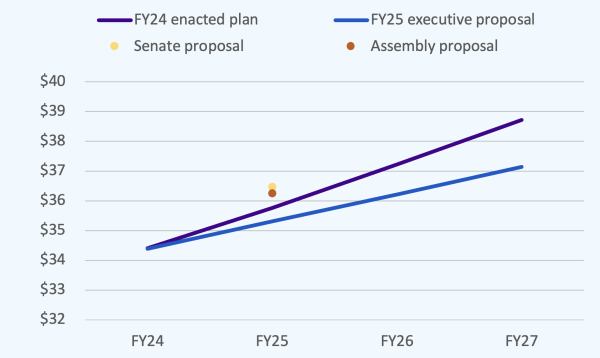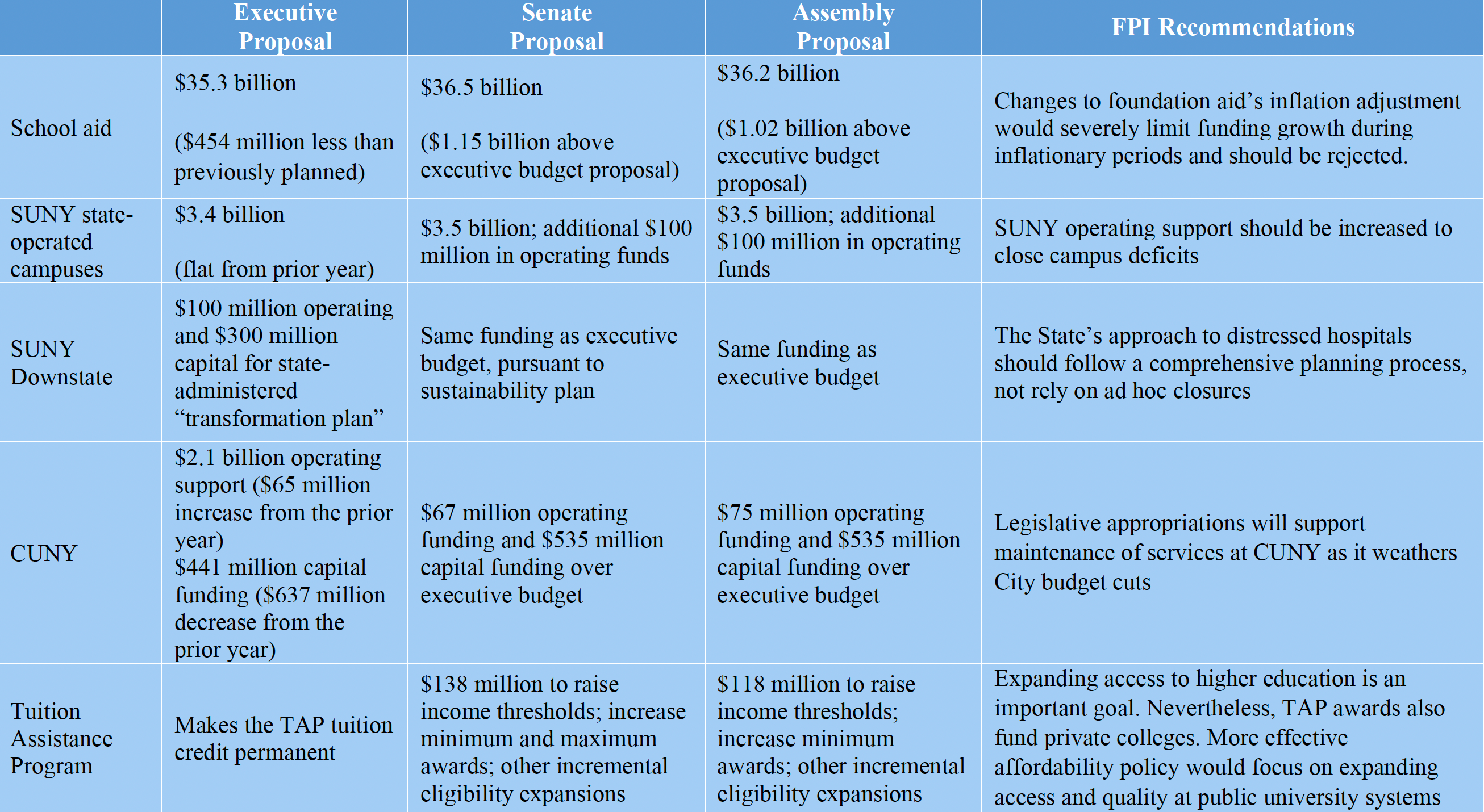Legislators Counter Executive Spending Restraint
Legislative proposals preserve current spending rather than providing transformative investments
The fiscal year 2025 executive budget attempts to curb State spending across major State-funded programs, in part by restraining the growth of school aid — the State’s largest single spending program. Further, the executive budget provides little additional support for public universities, despite growing fiscal strain on many campuses. Executive budget proposals are discussed in greater detail in FPI’s fiscal year 2025 annual budget briefing. The legislative budget proposals would roll back the executive budget’s proposed cuts to school aid and provide additional support for public higher education. This funding would preserve the current scope of New York’s education system, rather than representing transformative new investments
School Aid: Legislature rejects executive budget’s Foundation Aid changes
Support for local school districts is New York’s largest single spending program, accounting for more than one-quarter of State spending. After fast spending growth over the last three years, the fiscal year 2025 executive budget aims to curb school aid spending growth. To cut spending growth, the executive budget would change the inflation factor in the formula that determines Foundation Aid — the largest component of school aid funding — and eliminate the formula’s hold harmless provision, which prevents a school district’s aid from falling in any given year. These changes would reduce spending growth in fiscal year 2025 by $454 million. If adopted, the modified inflation adjustment would have a compounding effect, restricting school further in subsequent years.
Both the Senate and Assembly reject proposed changes to school aid, and instead propose higher school aid funding that more than makes up for the executive budget’s proposed cuts:
- The Senate would increase State-funded school aid by $1.16 billion, above the level proposed by the executive budget. The Senate’s additional funding would guarantee school districts a minimum annual increase of 3 percent, and add $150 million for statewide universal pre-kindergarten grants and $125 million for universal school meals.
- The Assembly would increase State-funded school aid by $1.02 billion above the level proposed by the executive budget. Like the Senate, the Assembly additional funding would guarantee school districts a minimum annual increase of 3 percent.
Figure 1. School aid planned by fiscal year 2024 enacted budget and fiscal year 2025 executive budget, and legislative proposals

Higher Education: Legislature proposes modest operating support to maintain services
The State’s higher education systems — the State University of New York (SUNY) and City University of New York (CUNY) — both have campuses facing fiscal strain despite recent upticks in enrollment. The executive budget makes no new investments in higher education systems, proposing to hold funding for SUNY and CUNY flat in fiscal year 2025. Meanwhile, the governor is advancing a plan to close SUNY Downstate, a State-operated hospital and medical school in Brooklyn.
Both legislative plans reject the Governor’s lack of investment with proposed operating support for SUNY and CUNY and plan to keep SUNY Downstate open. Further, both houses propose significant expansions to the tuition assistance program (TAP), which provides grants to students from low- and middle-income families:
SUNY colleges
The executive budget would hold State funding for SUNY’s four-year colleges and universities flat in fiscal year 2025. While the executive budget appears to make modest new operating support available, this funding is offset by the expiration of one-off funding passed last year.
The Senate and Assembly would each appropriate $100 million in additional operating support for SUNY colleges beyond the level proposed by the executive budget:
- The Senate’s $100 million appropriation would be divided among community colleges, the State-operated colleges (the system’s four-year campuses), and statutory colleges (state-supported institutions housed within non-state universities, such as the specialty schools at Cornell University).
- The Assembly’s $100 million appropriation would be divided only between State-operated and statutory colleges. The Assembly proposes a separate $11 million appropriation for community colleges. For this reason, the State’s four-year campuses would benefit from greater operating support under the Assembly plan.[1]
While these legislative proposals would increase operating support for SUNY, they would not fully bridge the fiscal gaps faced by many campuses. An estimated 19 SUNY campuses have operating deficits collectively totaling $138 million per year. Campuses with severe deficits — including SUNY Potsdam and Fredonia — have entered into restructuring agreements with the SUNY central administration, eliminating degree programs in exchange for emergency fiscal support. SUNY central administration expects this problem to worsen, with collective annual deficits exceeding $1 billion over the next decade. While the legislative proposals are a step in the right direction, deep, recurring funding will be necessary to shore up the SUNY system.
Finally, both the Senate and Assembly propose $670 million for capital investments. The State would be authorized to apportion this additional capital funding among SUNY campuses.
SUNY Downstate
In January 2024, SUNY announced a plan to close SUNY Downstate, a teaching hospital in Brooklyn. As part of the amended executive budget, the State committed $100 million in operating support and $300 million in capital funding to implement a “transformation plan,” a State-developed plan to relocate certain SUNY Downstate services to the adjacent Kings County Hospital Center, a City-supported hospital.
The Senate and Assembly both accept the executive budget’s proposed spending levels. The Senate, however, would make the capital funding conditional on a “sustainability plan.” The sustainability plan, which would be developed by a commission made up by executive, legislative, labor, and community appointees, would outline a strategy for retaining SUNY Downstate’s teaching and service capacity in five core medical practices defined by the Senate. Operating support would be used to support current services while the sustainability plan is finalized. The Assembly budget resolution expresses support for maintaining services at SUNY Downstate, though it does not include legislation conditioning capital funds.
Finally, both houses would add $79 million to support SUNY hospitals’ debt service, offsetting costs for the system’s three teaching hospitals, and $150 million in capital funding for SUNY hospitals.
CUNY
New York City’s public higher education system faces fiscal shortfalls as the City implements multiple rounds of across-the-board budget cuts. In its November 2023 and January 2024 budget modifications, the City implemented cuts to CUNY totaling $40 million annually.[2] These reductions follow cuts totaling $155 million enacted the prior year.[3] Despite a recent uptick in enrollment, the City appears poised to continue cutting CUNY funding, focusing on nine campuses judged to be “colleges of concern.”[4]
The executive budget maintains status quo support for CUNY, proposing an increase in operating support of $65 million, or 3.3 percent. At the same time, the State proposes dramatically reducing funding for CUNY capital projects, from $1.1 billion in fiscal year 2024 to $441 million in fiscal year 2025
The Senate and Assembly would add an additional $67 million and $75 million, respectively, to the executive budget’s proposed operating support.[5] Both houses would increase capital funding to $1.0 billion, $535 million above the executive budget level.
Tuition Assistance Program
New York’s tuition assistance program (TAP) provides grants to students from low- and middle-income families to pay for tuition at colleges and universities in New York State, whether public or private. The executive budget took a step to extend TAP by making permanent an existing tuition credit that allows TAP recipients to attend a SUNY or CUNY school tuition free.
The Senate and Assembly would enact a more sweeping expansion of TAP, proposing, respectively, $138 million and $118 million plans to broaden the program. Both houses would increase the current income threshold for TAP liability from $80,000 to $125,000 for dependent students and increase the minimum award level from $500 to $1,000. The Senate would further increase the maximum TAP award by $500 to $6,125. Both houses would expand access to TAP to part-time students in private colleges approved to be part of TAP. Finally, each house takes differing steps to incrementally expand TAP, with the Senate expanding access for students with disabilities and the Assembly extending the maximum duration of awards to five years.
Conclusion
Broad, well-funded school and higher education systems are essential to New York’s competitiveness. The fiscal year 2025 executive budget attempts to curb spending growth by restricting school aid to districts across the state and failing to address deficits at State- and City-operated public university campuses. The Senate and Assembly instead reject the proposed executive changes to school aid and add supplemental funding above the planned level prior to the cuts. The legislature also appropriates additional funding for the State and City’s public university systems. While the legislative proposals do not represent transformative investments in the State’s education system, they would shore up the precarious fiscal situations facing school and public universities across the state.
[1] The Assembly also includes $87 million for collective bargaining agreements for the SUNY workforce.
[2] New York City Office of Management and Budget, “Program to Eliminate the Gap” (January 2024), https://www.nyc.gov/assets/omb/downloads/pdf/peg1-24.pdf.
[3] Office of the New York City Comptroller, “Cuts to CUNY: An analysis of financial risk posed by cuts to the City University of New York in NYC’s FY 2024 Executive Plan” (May 2023), https://comptroller.nyc.gov/reports/cuts-to-cuny/.
[4 Cayla Bamberger, “CUNY orders deeper spending cuts, putting course options and student services at risk” New York Daily News (December 2023), https://www.nydailynews.com/2023/12/17/cuny-deeper-enhanced-budget-cuts-course-options-student-services-risk/.
[5] The Assembly would also provide $49 million for costs associated with collective bargaining.
Comparison of executive and legislative budget proposals

